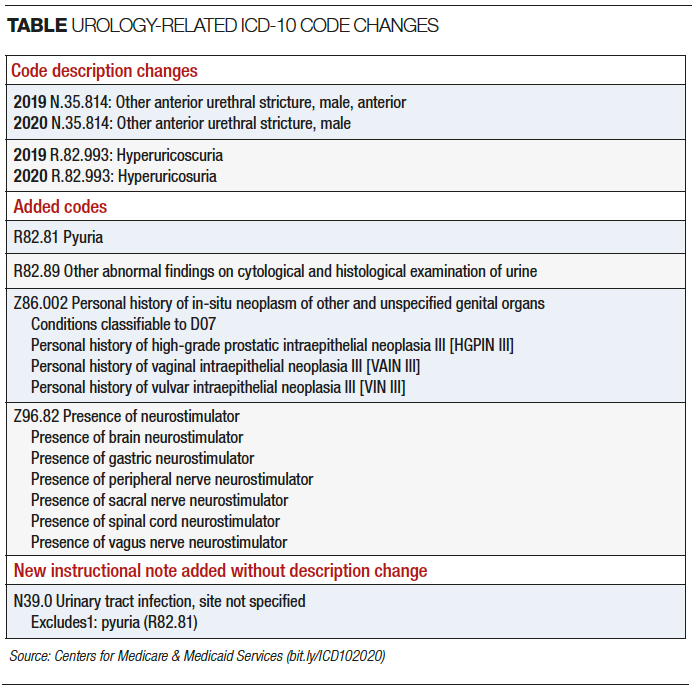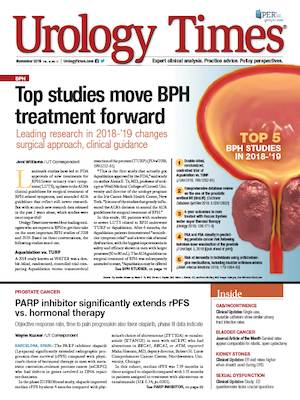Publication
Article
Urology Times Journal
ICD-10/CPT updates involve coding for strictures, orchiopexy
Author(s):
"One of the common issues we have noted for urology practices in updating ICD-10 codes is not the electronic medical record or practice management system failing to load new codes; rather, it is a failure to update templates," write Ray Painter, MD, and Mark Painter.
everythingpossible - stock.adobe.com


Ray Painter, MD

Mark Painter
Each year on Oct. 1, the new ICD-10 codes become effective. Over the past few years, this has resulted in a few major changes and a few changes that seemed minor but resulted in major payment delays. For 2020, the code set saw 273 new codes and 21 deleted codes. There were a number of changes to ICD-10 notes throughout the nomenclature but no major changes to the guidelines.
The table lists changes we have identified that could affect urology diagnosis coding. The list does not include changes that might be encountered for comorbidities but focuses on primary urologic issues.
Although the code changes don’t apply to billing and reporting for most urologists, the changes should be noted and appropriate steps taken for those affected.
Be sure to update templates
One of the common issues we have noted for urology practices in updating ICD-10 codes is not the electronic medical record or practice management system failing to load new codes; rather, it is a failure to update templates.
Using the new codes as an example, before the update on Oct. 1, 2019, code R82.8 (Abnormal findings on cytological and histological examination of urine) was a valid ICD-10 code that may have been tied to either a specific shortcut list for a provider or to a specific HPI macro to prepopulate the charge communication form. As of Oct. 1, 2019, the same diagnosis now requires the addition of an additional digit R82.89 (Other abnormal findings on cytological and histological examination of urine).
Also by the Painters: Hospital refuses access to EOBs; what can I do?
Any shortcut lists or templates will also need to be updated. Many practices experienced-and are still experiencing-a lack of an additional digit for elevated PSA R97.20 (instead of R97.2), an update that occurred in 2017.
CPT code updates
Updates for CPT 2020 have been released for an effective date of Jan. 1, 2020. Relative value units for new codes will not be released until the final rule is published (likely the first part of November).
Several CPT category III codes were added for Jan. 1, 2020 but were released early per CPT policy on July 1, 2019. Category III codes are often treated by payers as experimental procedures and therefore not covered. However, some payers will develop payment policies for these services as data become available to support medical necessity, safety, and efficacy. CPT nomenclature rules dictate that the category III code should be used instead of an unlisted code from the appropriate section of CPT.
Payer interpretation of this CPT rule varies. You will need to check with each payer prior to reporting these services. The new codes pertain to transperineal periurethral balloon device (0548T-0551T) and transurethral ablation of malignant prostate tissue by high-energy water vapor thermotherapy (0582T).
Note that the Rezum procedure for BPH is still reported with code 53854. The new category III code 0582T is for treatment of malignant prostate tissue.

Additionally, a new series of category III codes 0587T-0590T for insertion, replacement, or removal integrated single device neurostimulation system and the analysis and testing was released that will become active Jan. 1, 2020.
The following change in description will become effective Jan. 1, 2020: 54640 (Orchiopexy, inguinal approach, with or without hernia repair) will change to 54640 (Orchiopexy, inguinal or scrotal approach). This description change was made to reflect the current National Correct Coding Initiative coding data set that will allow reporting of hernia repair with orchiopexy, as well as adding scrotal approach.
Code 90911 (Biofeedback training, perineal muscles, anorectal or urethral sphincter, including EMG and/or manometry) was deleted and replaced with the following codes: 90912 (Biofeedback training, perineal muscles, anorectal or urethral sphincter, including EMG and/or manometry, when performed; initial 15 minutes of one-on-one physician or other qualified health care professional contact with the patient) and 90913 (each additional 15 minutes of one-on-one physician or other qualified health care professional contact with the patient). Parenthetical instructions have also been added.
While the changes for CPT codes in urology have been minimal over the last 2 years, we feel it important to address one change introduced for 2019 related to percutaneous nephrolithotomy, which we still receive a number of questions about. The following new codes were introduced in 2019:
• 50436 Dilation of existing tract, percutaneous, for an endourologic procedure including imaging guidance (eg, ultrasound and/or fluoroscopy) and all associated radiological supervision and interpretation, with postprocedure tube placement, when performed
• 50437 Dilation of existing tract, percutaneous, for an endourologic procedure including imaging guidance (eg, ultrasound and/or fluoroscopy) and all associated radiological supervision and interpretation, with postprocedure tube placement, when performed; including new access into the renal collecting system.
Continue to the next page for more.The 2019 CPT manual also included the following note under codes 50080 (Percutaneous nephrostolithotomy or pyelostolithotomy, with or without dilation, endoscopy, lithotripsy, stenting, or basket extraction; up to 2 cm) and 50081 (Percutaneous nephrostolithotomy or pyelostolithotomy, with or without dilation, endoscopy, lithotripsy, stenting, or basket extraction; over 2 cm).
• For establishment of nephrostomy without nephrostolithotomy, see 50040, 50432, 50433, 52334.
• For fluoroscopic guidance, use 76000.
• Do not report 50080 or 50081 in conjunction with 50436 or 50437, when performed by the same physician or other qualified health care professional.
Bundling edits corresponded with the CPT note.
Read: How to improve patients’ access to their health information
As the description for 50080 and 50081 includes dilation, endoscopy, lithotripsy, stenting, or basket extraction, these services cannot be reported with a separate CPT code during the same session. Likewise, codes 50436 and 50437 are not to be reported when provided by the same physician, group, or advanced practice provider employed by the practice.
According to an AUA “Coding Corner” article, however, placement of a nephrostomy tube by the urologist can be separately reported with CPT code 50432 with code 50080 or 50081 when performed (bit.ly/auacodingcorner).
Code 76000, as noted in CPT, may be reported; however, many payers will deny the code, which is listed as a separate procedure. Medicare does not include 76000 in the NCCI data set. Nor is 74420 included in the bundle. It should be noted that any radiology code reported must be supported by clear and separate dictation in the medical record. We have recommended that documentation reflect similar analysis and findings to those found in a radiology report provided by a radiologist.
The information in this column is designed to be authoritative, and every effort has been made to ensure its accuracy at the time it was written. However, readers are encouraged to check with their individual carrier or private payers for updates and to confirm that this information conforms to their specific rules.


Clarifying coding for percutaneous nephrolithotomy procedures




